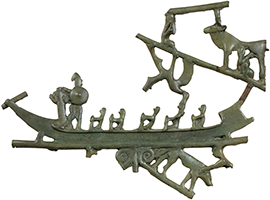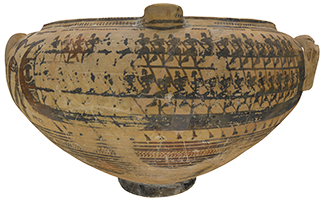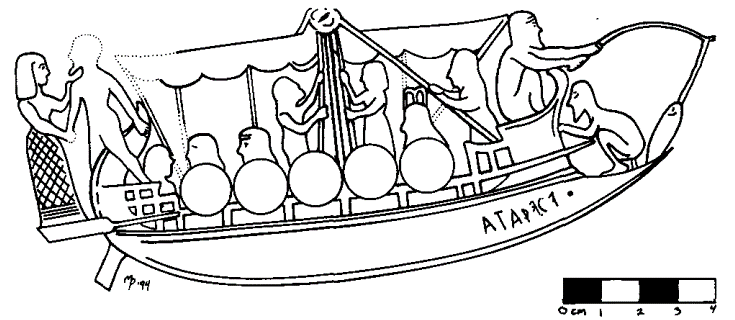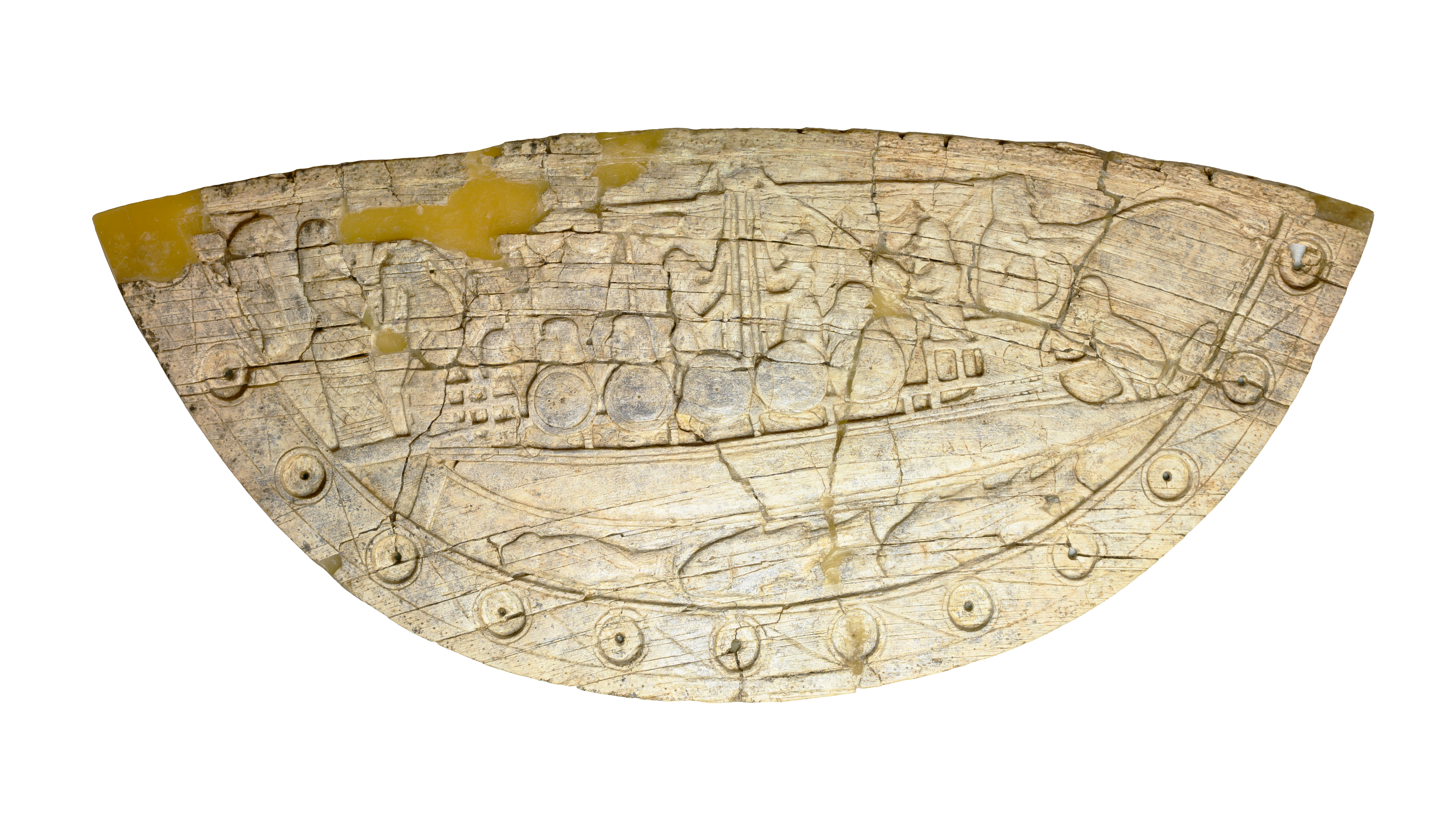Single-levelled ship to the right with a low, slightly rockered hull. Massive square bow with a vertical stempost integrating the bow projection, ending in a short incurving horn device. High incurving sternpost ending in a thick horn device curving inward then upward at the tip. The forecastle is square and solid, with an additional lattice railing attached that is slightly shorter. The aftercastle consists entirely of a lattice railing. The sheer is delineated by two wales that run from post to post, rendered by three parallel horizontal lines stacked closely together. Above it is a raised railing supported by five vertical stanchions along which five shields are slung. In Pridemore's corrected drawing, this horizontal railing continues along the side of the forecastle and extends past the stempost into a proembolion (subsidiary ram). Previous erroneous readings thought of this horizontal part as the second arm of the squatting figure. The mast is amidships with a circular mast-head. The yard is straight and extends from post to post with a furled sail. The rigging is quite detailed and includes two braces and seven brails spaced evenly along the yard. There are two quarter rudder with rectangular oar blades. One of them is shown in front of the aftercastle and extends behind the sternport in a horizontal position. The second appears below the stern, with only part of the oar blade visible. The two figures operating the brails near the mast suggest a possible narrow central deck.
Departure sceme
A78
Late 8th-7th century B.C. (600 B.C. terminus ante quem)
Sanctuary of Artemis Orthia, Sparta
L: 24 cm; W: 11 cm
Semicircular ivory plaque with inscription and missing inlays (possibly amber)
Inscription: Ϝορθαια
Athens National Museum 15362
Basch 1987: 239-41, nos. 506-508; Casson 1995: 60; Dawkins 1906-7: pl. IVb; 1929: pl. CX; Fittschen 1969: 52-3, 58-9; Floren 1987: 219; Kirk 1949: 121-22; Langdon 1998: 267, fig.13; LIMC IV. I. 320-1; Marangou 1969: 83-90; Morrison-Williams 1968: Arch.31, pl. 10d; Pavlides 2011: 41, 230, fig. 13; Pridemore 1995: 161-64, figs. 1-2; Spathari 1995: 86-87, fig. 87; Wachsmann 1998: 191, fig. 8.56b
Over 200 ivory plaques have been recovered from the sanctuary of Artemis Orthia. These were divided into eight styles that increase in elaboration over time. This plaque belongs to style 5, which is considered to show the best reliefs and provides a wider variety of subjects compared to the other styles. It is the largest and most detailed of the group and was found associated with Laconian I and II pottery which provide its date. The plaque is framed along its circular edge with a series of 13 small hollow circles roughly 0.8 cm in diameter which most likely held inlays. The material of these inlays was possibly amber, as suggested by another plaque from the site (Dawkins 1929: 214). There is an inscription on the hull below the forecastle which is a shortened version of the goddess Orthia’s name. This suggests that the plaque is an ex-voto, offered as a token to secure a safe voyage.
The composition is very detailed, depicting a complex scene of departure with eleven figures shown in and around the ship. On the left, a bearded male figure facing left (main protagonist) faces a woman on the shore. He is striding with his left foot still standing on the aftercastle, while his right foot is already outside of the ship. His right hand grasps the woman’s wrist, while she places her left hand on his shoulder. The seemingly composed stance of the woman and her affectionate gesture favour an interpretation of this scene as one of farewell rather than abduction, similar to Oddysseus’ farewell to Penelope where he grips her wrist (Od.18.258). Several scholars have made identifications with myth, such as a scene showing Helen and Paris (LIMC I. I. 509-10; Floren 1987, 21) or Menelaus leaving Crete (Marangou 1969 83-90). Fittschen meanwhile argues for a generic scene of abduction based on the ‘hand on wrist‘ motif (Fittschen 1969: 52-3, 58-9).
The helmsman is shown seated behind the railing of the aftercastle facing three soldiers sitting behind a row of shields. Two figures stand on each side of the mast operating the brails. The absence of figures sitting behind the two shields amidships indicate that they have temporarily left their positions along with the other sitting warriors. A third figure stands behind the railing of the forecastle facing left and holding the fore brace. Another man facing towards the bow is shown squatting on top of the forecastle in the process of fishing, with a fish at the end of his pole. The last figure on the right is squatting on top of the ram and appears to be defecating while holding on to the stempost with his right hand. Three fish swim below.
The shields provide a clear indication that the horizontal
supported by the struts is a rail and not the deck. The placement of
such protective shields is a very typical and consistent feature of
Phoenician ship imagery that persists down to Classical period coinage.
The rigging details bear remarkable similarities to the Karatepe ship.
The composition is exceptional for the amount of detail pertaining to
everyday life on board. The only other ship depiction with a
sailor relieving himself comes from a Cypro-Archaic source.
Pierattini identifies the circular device on the masthead as a pully, and comments how shipbuilding technology was a likely source of innovation in the development of the first lifting machines that could then be applied to construction. The handling of rigging encouraged such experimentation, in particular when loading cargo (Pierattini 2019: 191-192).
Basch, L. 1987. Le musée imaginaire de la marine antique. Athens: Institut Hellénique pour la preservation de la tradition nautique.
Casson, L. 1995. Ships and Seamanship in the Ancient World. Baltimore: Johns Hopkins University Press.
Dawkins, R. M. 1906-7. “The sanctuary of Artemis Orthia,” in R. M. Dawkins, A. J. B. Wace, J. P. Droop, G. Dickins, H. J. W. Tillyard, A. M. Woodward and M. N. Tod (eds.) Laconia. I. Excavations at Sparta, 1907. BSA 13: 44-108.
―――. 1929. The Sanctuary of Artemis Orthia at Sparta. London: Macmillan.
Fittschen, K. 1969. Untersuchungen zum Beginn der Sagendarstellungen bei den Griechen. Berlin.
Floren, J. 1987. Die Griechische Plastik I: die Geometrische und Archaische Plastik. Munich.
Kirk, G.S. 1949. “Ships on Geometric Vases.” BSA 44: 93-153, pls. 38-40.
Langdon, S. 1998. “Significant Others: The Male-Female Pair in Greek Geometric Art,” AJA 102. 2: 251-270.
Levy, Y. 1988. Lexicon iconographicum mythologiae classicae (LIMC). IV.1. Eros - Herakles. München: Artemis Verlag.
Marangou, E. L. 1969. Lakonische Elfenbein und Beinschnitzereien. Tübingen.
Morrison, J.S. and R.T. Williams. 1968. Greek Oared Ships: 900-322 B.C. Cambridge: Cambridge University Press.
Pavlides, N. A. 2011. “Hero-Cult in Archaic and Classical Sparta: a Study of Local Religion.” PhD Thesis. The University of Edinburgh, UK.
Pridemore, M. G. 1995. “A re‐examination of a Ship on an Ivory Plaque from Sparta,” IJNA 24.2: 161-164.
Spathari, E. 1995. Sailing through Time: The Ship in Greek Art. Athens: Kapon Editions.
Wachsmann, S. 1998. Seagoing Ships & Seamanship in the Bronze Age Levant. College Station, TX: Texas A&M University Press.







